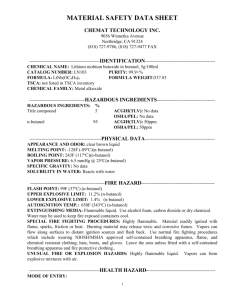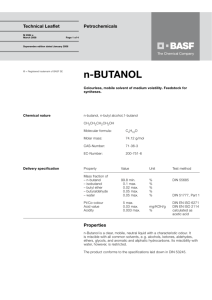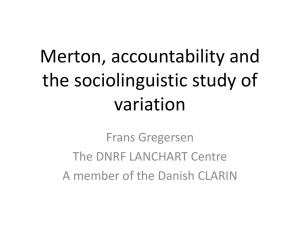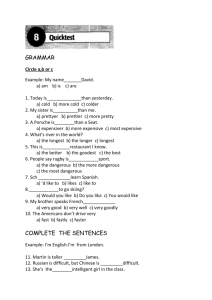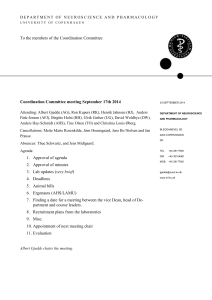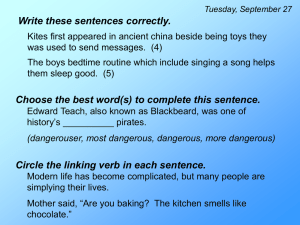1321580
advertisement
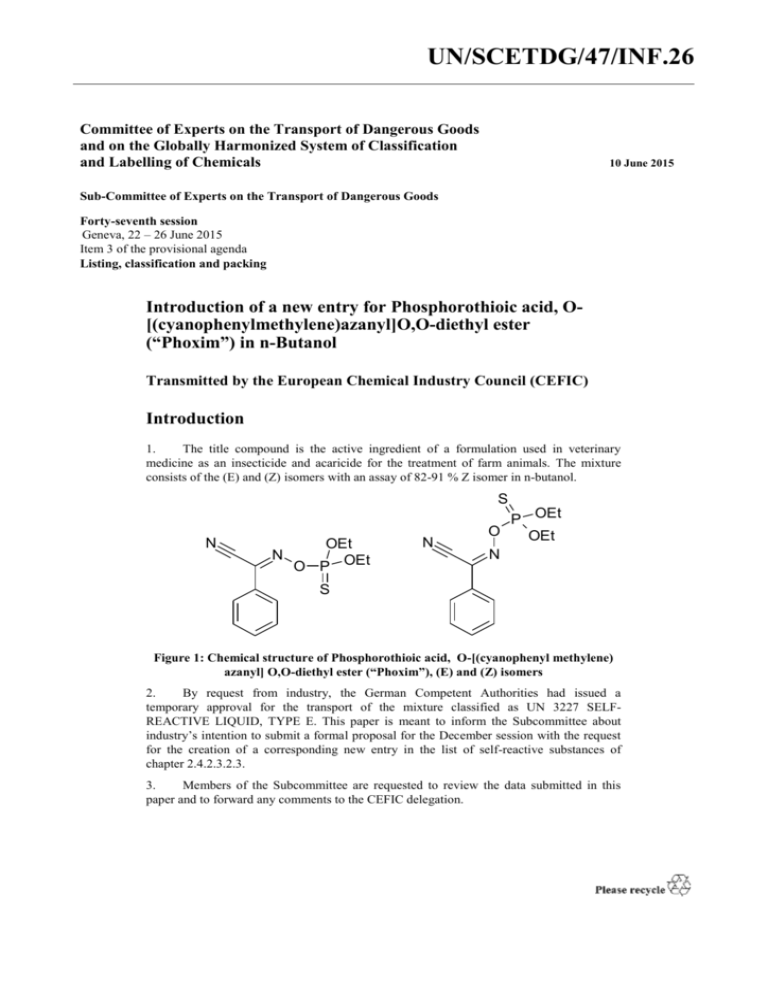
UN/SCETDG/47/INF.26 Committee of Experts on the Transport of Dangerous Goods and on the Globally Harmonized System of Classification and Labelling of Chemicals 10 June 2015 Sub-Committee of Experts on the Transport of Dangerous Goods Forty-seventh session Geneva, 22 – 26 June 2015 Item 3 of the provisional agenda Listing, classification and packing Introduction of a new entry for Phosphorothioic acid, O[(cyanophenylmethylene)azanyl]O,O-diethyl ester (“Phoxim”) in n-Butanol Transmitted by the European Chemical Industry Council (CEFIC) Introduction 1. The title compound is the active ingredient of a formulation used in veterinary medicine as an insecticide and acaricide for the treatment of farm animals. The mixture consists of the (E) and (Z) isomers with an assay of 82-91 % Z isomer in n-butanol. S N N OEt O P OEt N P OEt O OEt N S Figure 1: Chemical structure of Phosphorothioic acid, O-[(cyanophenyl methylene) azanyl] O,O-diethyl ester (“Phoxim”), (E) and (Z) isomers 2. By request from industry, the German Competent Authorities had issued a temporary approval for the transport of the mixture classified as UN 3227 SELFREACTIVE LIQUID, TYPE E. This paper is meant to inform the Subcommittee about industry’s intention to submit a formal proposal for the December session with the request for the creation of a corresponding new entry in the list of self-reactive substances of chapter 2.4.2.3.2.3. 3. Members of the Subcommittee are requested to review the data submitted in this paper and to forward any comments to the CEFIC delegation. UN/SCETDG/47/INF.26 Test data 4. All tests were performed according to the methods specified in the UN Recommendations on the Transport of Dangerous Goods, Manual of Tests and Criteria, fifth revised edition, with amendments 1 and 2. 5. The classification procedure led to the final result (Figure 20.1 of the UN Test Manual) Exit E, accepted for transport in packages of not more than 400 kg/ 450 litres. Details are specified in the test report in Annex I. Proposal 6. In chapter 2.4.2.3.2.3, create an entry in the list of self-reactive substances as follows SELF-REACTIVE SUBSTANCE Phosphorothioic acid, O-[(cyanophenyl methylene) azanyl] O,Odiethyl ester 7. Concentration (%) 82-91 Packing method Control temperature Emergency temperature (°C) (°C) OP 8 UN generic entry 3227 (Z isomer) Add a new remark (10) at the end of the same chapter as follows: (10) This entry applies to the technical mixture in n-Butanol with the concentration limits of the (Z) isomer. Justification 8. The fact that the product is carried in large quantities and is used worldwide justifies a new entry in the list of self-reactive substances. The test results are clear, and a formal temporary approval has been issued for all modes by the German authorities. The concentration limits apply to the product as registered for veterinary purposes. 2 Remarks (10) UN/SCETDG/47/INF.26 Annex I Test report 1. Name of substance Phosphorothioic acid, O-[(cyanophenyl methylene) azanyl] O,O-diethyl ester 2. General data 2.1 Composition 88.1 % active ingredient 2.1 % sum of impurities Solution in n-Butanol 2.2 Molecular formula: C12H15N2O4PS 2.3 Available oxygen content Not applicable 2.4 Activator content Not applicable 2.5 Physical form Liquid 2.6 Colour Dark yellow 2.7 Apparent density 1130 kg/m³ 2.8 Particle size Not applicable 3. Detonation (test series A) 3.1 Box 1 of the flow chart Does the substance propagate a detonation? Method BAM 50/60 steel tube test (test A.1), test in cavitated state (German method) 3.2 Sample conditions Ambient temperature 3.3 Observations 190 mm of tube fragmented, unreacted substance remained in the tube 3 UN/SCETDG/47/INF.26 3.4 Result No 3.5 Exit 1.3 4. Deflagration (test series C) Box 5 of the flow chart Does the substance propagate a deflagration? 4.1 Method 1 Time/pressure test (test C.1) 4.2 Sample conditions Ambient temperature 4.3 Observations Time 310-330 ms 4.4 Result Yes, slowly 4.5 Method 2 Deflagration test (test C.2) 4.6 Sample conditions Temperature 40 °C 4.7 Observations Deflagration rate 0.30 mm/s 4.8 Result No 4.9 Overall result No 4.10 Exit 5. 5.3 Heating under confinement (test series E) Box 9 of the flow chart What is the effect of heating it under defined confinement? 5.1 Method 1 Koenen test (test E.1) 5.2 Sample conditions Mass 32.1 g 5.3 Observations Limiting diameter 1.0 mm (time to reaction 28 s, duration of reaction 14 s) 5.4 Result Low 5.5 Method 2 Dutch pressure vessel test (test E.2) 5.6 Sample conditions 10.0 g 5.7 Observations Limiting diameter 2.0 mm (time to reaction 51 s) No rupture of the disc with an orifice of 3.5 mm but rupture of the disc with an orifice of 2.0 mm 5.8 Result Low 5.9 Overall result Low 5.10 Exit 9.3 6. Is the self-reactive substance to be considered Box 11 of the flow chart for transport in IBCs or tanks, or for exemption? 6.1 4 Result No UN/SCETDG/47/INF.26 6.2 Exit 11.2 Accepted for transport in packages of not more than 400kg/450 litres 7. 7.1 Thermal stability (test series H) Method 7.2 Heat accumulation storage test (H.4) Sample conditions 400 ml substances in Dewar vessel, heat loss 35-42 mW/kgK 7.3 Observations Auto-accelerating decomposition at 75 °C, No reaction at 50°C and 60 °C 7.4 Result No temperature control required 8. Additional data (see 20.5.3) 8.1 Method BAM fallhammer test (test 3 (a) (ii)) 8.2 Sample conditions Ambient temperature 8.3 Observations No explosion up to an impact energy of 40 J 8.4 Result Not sensitive to impact 8.5 Method BAM friction apparatus (test 3 (b) (i)) 8.6 Sample conditions Ambient temperature 8.7 Observations No explosion up to a friction load of 360 N 8.8 Result Not sensitive to friction 8.9 Method DSC 8.10 Sample conditions Closed glass crucible, heating rate 3 K/min) 8.11 Observations Exothermic decomposition of about 1100 kJ/kg, onset of 90 °C. 9. Proposed assignment 9.1 Proper shipping name SELF-REACTIVE LIQUID, TYPE E 9.2 UN number 3227 9.3 Division 4.1 9.4 Technical name Phosphorothioic acid, O-[(cyanophenyl methylene) azanyl] O,O-diethyl ester 9.5 Concentration 82-91 % (Z isomer) 9.6 Diluent n-Butanol 9.7 Subsidiary risks None 9.8 Packing group 9.9 Packing method OP8 9.10 Control temperature Not required 9.11 Emergency temperature Not required 5 UN/SCETDG/47/INF.26 Annex II Data sheet to be submitted to the United Nations for new or amended classification of substances Submitted by Bayer HealthCare AG, 51368 Leverkusen, Germany May 12th, 2015 Date: Supply all relevant information including sources of basic classification data. Data should relate to the product in the form to be transported. State test methods. Answer all questions - if necessary state “not known” or “not applicable” - If data is not available in the form requested, provide what is available with details. Delete inappropriate words. Section 1: Substance identity 1.1 Chemical name Phosphorothioic acid, O-[(cyanophenyl methylene) azanyl] O,O-diethyl ester, mixture of (E) and (Z) isomers dissolved in n-Butanol (concentration of Z isomer 82-91 %) 1.2 Chemical formula (C6H5)-C(CN)=N-O-PS(OEt)2 1.3 Other names/synonyms Phoxim VL, Phoxim VL 80, Sebacil VL 80, Volaton; 1.4.1 UN number: ....... 3227 1.4.2 CAS number …….. 1.5 14816-18-3 (Phoxim), CAS 71-36-3 (butanol) Proposed classification for the Recommendations 1.5.1 Proper shipping name (3.1.21) SELF-REACTIVE LIQUID, TYPE E 1.5.2 class/division 4.1 ..... subsidiary risk(s) ……………………………… packing group ………………………………………………………… 1.5.3 proposed special provisions, if any 1.5.4 proposed packing instruction(s) P520, OP8 274 Section 2: Physical properties 2.1 Melting point or range -90 °C (n-butanol) 2.2 Boiling point or range 116 °C – 118 °C (n-butanol) 2.3 Relative density at: 2.4 1 6 2.3.1 ................... 15 °C not known 2.3.2 ................... 20 °C 1.13 g/cm3 2.3.3 ................... 50 °C not known Vapour pressure at: 2.4.1 ................... 20 °C 0.35 kPa 2.4.2 ................... 50 °C not known 2.4.3 ................... 65 °C not known This and similar references are to chapters and paragraphs in the Model Regulations on the Transport of Dangerous Goods. UN/SCETDG/47/INF.26 2.5 Viscosity at 20 °C2 ....... not known 2.6 Solubility in water at 20 °C ............ : not miscible 2.7 Physical state at 20°C (2.2.1.11) 2.8 Appearance at normal transport temperatures, including colour and odour: yellow-brownish liquid, aromatic odour ….…………………………………………………………………………… 2.9 Other relevant physical properties: pH 3.9 at 10 g/l liquid2 ………………………………………………………………………………. ………………………………………………………………………………. Section 3: Flammability 3.1 Flammable vapour 3.1.1 Flash point (2.3.31) 38 °C (closed cup) 3.1.2 Is combustion sustained? (2.3.1.31) yes 3.2 Autoignition temperature 3.3 Flammability range (LEL/UEL) 1.4 / 11.3 % (n-butanol) 3.4 Is the substance a flammable solid? (2.4.2 1) 3.4.1 not known no If yes, give details not applicable ………………………………. ……………………………………………………………………….. ………………………………………………………………………. ………………………………………………………………………. Section 4: Chemical properties 4.1 Does the substance require inhibition/stabilization or other treatment such as nitrogen blanket to prevent hazardous reactivity ? no If yes, state: 4.2 4.1.1 Inhibitor/stabilizer used not applicable ……………………………. 4.1.2 Alternative method not applicable ……………………………. 4.1.3 Time effective at 55 °C not applicable …………………………….. 4.1.4 Conditions rendering it ineffective not applicable ………………… Is the substance an explosive according to paragraph 2.1.1.1? (2.1 1) 4.2.1 If yes, give details no not applicable …………………………………... ……………………………………………………………………………. ……………………………………………………………………………. ……………………………………………………………………………. 2 1 See definition of "liquid" in 1.2.1 of the Model Regulations on the Transport of Dangerous Goods. This and similar references are to chapters and paragraphs in the Model Regulations on the Transport of Dangerous Goods. 7 UN/SCETDG/47/INF.26 4.3 Is the substance a desensitized explosive? (2.4.2.4 1) 4.3.1 If yes, give details no not applicable …………………………………………. ……………………………………………………………………………………………. ……………………………………………………………………………………………. 4.4 Is the substance a self-reactive substance? (2.4.11) yes If yes, state: 4.4.1 exit box of flow chart: E What is the self-accelerating decomposition temperature (SADT) for a 50 kg package? 60 °C < SADT < 75 °C Is the temperature control required? (2.4.2.3.4 1) 4.5 no 4.4.2 proposed control temperature for a 50 kg package not applicable 4.4.3 proposed emergency temperature for a 50 kg package not applicable Is the substance pyrophoric? (2.4.31) no 4.5.1 If yes, give details not applicable ……………………………………………………………………………………………… ………………………………………………………………………………………………. ………………………………………………………………………………………………. 4.6 Is the substance liable to self-heating? (2.4.31) no 4.6.1 If yes, give details not applicable ………………………………………………………………………………………………. ………………………………………………………………………………………………. ………………………………………………………………………………………………. 4.7 Is the substance an organic peroxide (2.5.1 1) no If yes state: 4.7.1 exit box of flow chart not applicable ……………………………………… What is the self accelerating decomposition temperature (SADT) for a 50 kg package? °C Is temperature control required? (2.5.3.4.1 1) 4.8 no 4.7.2 proposed control temperature for a 50 kg package not applicable 4.7.3 proposed emergency temperature for a 50 kg package not applicable Does the substance in contact with water emit flammable gases? (2.4.4 1) 4.8.1 If yes, give details no not applicable ……………………………………………………………………………………………… ………………………………………………………………………………………………. ………………………………………………………………………………………………. 4.9 Does the substance have oxidizing properties (2.5.1 1) no 4.9.1 If yes, give details not applicable ………………………………………………………………………………………………. ………………………………………………………………………………………………. ……………………………………………………………………………………………….. 1 8 This and similar references are to chapters and paragraphs in the Model Regulations on the Transport of Dangerous Goods. UN/SCETDG/47/INF.26 4.10 Corrosivity (2.81) to: 4.10.1 mild steel not known at ………………………………..C 4.10.2 aluminium not known at………………………………..C 4.10.3 other packaging materials (specify) not known ............. 4.11 at ……………………………….C Other relevant chemical properties: see test report in Annex I Section 5. Harmful biological effects 5.1 LD50, oral (2.6.2.1.11) 300 – 2000 mg/kg Animal species................................ rat (Phoxim (ISO)) 5.2 LD50, dermal (2.6.2.1.21) > 2000 mg/kg Animal species................................ rat (Phoxim (ISO)) 5.3 LC50, inhalation (2.6.2.1.31).... > 4 mg/litre Exposure time 4 hours ............. ............. Animal species................................ rat (Phoxim (ISO)) 5.4 Saturated vapour concentration at 20 °C (2.6.2.2.4.3 1) 5.5 Skin exposure (2.81) results not known Exposure time ................................................................ hours/minutes Animal species ....................................................................................... 5.6 Other data: Causes skin irritation (GHS H315) ....................................................................................................................................................................... ....................................................................................................................................................................... 5.7 Human experience not known ...................................................................................................... ....................................................................................................................................................................... ....................................................................................................................................................................... Section 6. Supplement information 6.1 Recommended emergency action 6.1.1 Fire (include suitable and unsuitable extinguishing agents) Suitable: alcohol-resistant foam, dry chemical or carbon dioxide; unsuitable: water 6.1.2 Spillage . Keep away from sources of ignition. Cover spilled product with liquid-binding material (sand, silica gel, acid binder, universal binder, hybilat). Take up mechanically and fill into labelled, closable containers. 6.2 Is it proposed to transport the substance in: 6.2.1 Bulk Containers (6.81) no 1 6.2.2 Intermediate Bulk Containers (6.5 ) no 6.2.3 Portable tanks (6.71)? no If yes, give details in Sections 7, 8 and/or 9. 1 1 This and similar references are to chapters and paragraphs in the Model Regulations on the Transport of Dangerous Goods. This and similar references are to chapters and paragraphs in the Model Regulations on the Transport of Dangerous Goods. 9 UN/SCETDG/47/INF.26 Section 7: Bulk containers (only complete if yes in 6.2.1) 7.1 Proposed type(s) not applicable ............................................................................. Section 8: Intermediate bulk containers (IBCs) (only complete if yes in 6.2.2) 8.1 Proposed type(s) not applicable ......................................................................................... Section 9: Multimodal tank transport (only complete if yes in 6.2.3) 10 9.1 Description of proposed tank (including IMO tank type if known) not applicable.............. 9.2 Minimum test pressure not applicable ........................................................................... 9.3 Minimum shell thickness not applicable ............................................................................ 9.4 Details of bottom openings, if any 9.5 Pressure relief arrangements 9.6 Degree of filling 9.7 Unsuitable construction materials not applicable ............................................................... not applicable ....................................................................... not applicable ................................................................................... not applicable.............................................................
